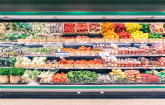Chicory Survey Reveals That Over 50% of Consumers Place an Online Grocery Order Once a Week or More Often
Chicory Releases Fifth Iteration of Consumer Survey Exploring Year Over Year and Quarterly Changes in Online Grocery Usership
NEW YORK, Feb. 4, 2021 /PRNewswire/ -- Today, Chicory, the leading digital shopper marketing platform for CPG and grocery companies, released the results of a new national grocery consumer research study, Online Grocery Usership Changes Year Over Year. The results of this fifth quarterly consumer survey quantify the impact of COVID-19 on online grocery usage by comparing current 2021 results to past quarterly studies throughout 2020. For an infographic of the high-level data captured from this survey, please visit this link.
Instacart and Shipt Gained the Most Reported Users Year Over Year
Today, Walmart (55.77%) and Amazon (36.36%) are still frontrunners in the online grocery wars, but survey results demonstrate that other retailers like Target and Kroger and marketplaces like Instacart and Shipt have gained self reported users from Amazon (-9.01%) from October 2020 to January 2021.
However, both Walmart (+0.52%) and Amazon (+8.52%) gained online grocery users year over year. All other retailers also gained new users, indicating that there are just more online grocery users in the market compared to a year ago.
Here is how the amount of online grocery users shifted for each retailer year over year:
- Walmart: +0.52%
- Amazon: +8.52%
- Kroger: +23.60%
- Instacart: +47.90%
- Shop & Shop/Giant Foods: +26.17%
- Shipt: +56.96%
- Albertsons/Safeway: +7.80%
"It's no coincidence that grocery marketplaces Shipt and Instacart had the largest increases in online grocery users year over year compared to other retailers from pre-COVID-19 to present," said Yuni Sameshima, Chicory's CEO and Co-Founder. "It's clear that shoppers value the versatility and convenience of retailer choice and an emphasis on the rapid delivery portion of the business, rather than retailer loyalty. Further, Instacart's grocery delivery model has the most versatility and flexibility to scale compared to a brick and mortar retailer."
Online Grocery Usership Grows by 27.17% Year Over Year
Online grocery usership growth indicates that, despite shoppers being settled into the new normal, they're still choosing to shop for their groceries online.
In fact, usage in January 2021 exceeds usage in:
- April 2020 by 10.26%
- July 2020 by 15.22%
- October 2020 by 8.86%
Weekly Online Grocery Orders and List-Building Continues to Accelerate
The majority of respondents, 64.86%, add to their shopping cart weekly or more often, following typical shopping list building habits. Further, 26% more consumers place an online grocery order once a week now compared to a year ago.
35.14% of respondents add items to their shopping cart every few weeks in the most recent survey, indicating that these shoppers build their list all at once, as they get ready to buy. This is a large decrease of 27.68% year over year, demonstrating that more consumers are shifting to use online grocery carts as regular shopping lists, adding products incrementally.
"Interestingly, the frequency at which consumers place an online grocery order was nearly the same in January 2021 compared to October 2020," said Sameshima. "January 2021 survey results found an almost even split between consumers who place an online grocery order once a week or more often, 52.58%, and those that do so once a month or more infrequently, 47.42%. This continues to demonstrate that there are two distinct online grocery users: those who regularly use online grocery services to replace their regular in-store shopping and those who use online grocery services to supplement their in-person trips for specialty or bulky items."
Omnichannel Shopping Continue to Upward Trend
There is a discrepancy between how many consumers place an order once a week or more often (52.58%) and how many add to their shopping carts weekly or more often (64.86%). Similarly, there is the same discrepancy between how many consumers place an order monthly or more infrequently (47.42%) and how many add to their shopping carts every few weeks (35.14%).
This indicates that there isn't necessarily a linear relationship between the online grocery cart and online grocery orders. Omnichannel consumers may add to their online shopping carts in order to take advantage of aisle location features while shopping in-store. Others may be creating lists on their phones or on paper and then adding those items to their cart and checking out all at once.
When we dig deeper into the way that online grocery users shop in-store, 31.79% of consumers who place an online grocery order once a week also shop for their groceries in-store once a week. 30.64% of consumers who place an online grocery order once a week also shop in-store a few times a month, illustrating a more straightforward type of consumer: one who does their regular grocery shopping online, and supplements those shops with in-store purchases.
Online Shopping Frequency and Spend Mirror In-Store Behavior
Shoppers in January 2021 indicate that they're more regularly incorporating online grocery shopping into their regular shopping habits, and spending is beginning to mimic regular in-store trips.
In January 2021, we see a return to height-of-the-pandemic spending levels, with more shoppers completing an average trip ($60). More shoppers in January 2021 completed a $50-$75 online grocery shopping trip than in all other quarters (31.20%), even exceeding January 2020 by 28.99% and eking by April 2020, the height of the pandemic, by 1.84%.
"31% of consumers are meeting average thresholds for their online grocery purchases, plus 43% are placing an online grocery order once a week, indicating that many consumers are completely replacing regular in-store grocery shopping trips with online orders. We're seeing sustained frequent online grocery shopping behavior, and this leveling off of average trip spend indicates that it's becoming a habitual behavior to conduct entire grocery shopping trips online," said Sameshima.
The Role of Content and Digital Tools
Chicory's survey found that many consumers use online tools like digital recipes to plan for their in-store grocery shopping trips. Over half (52.43%) of consumers use digital recipes and other online tools once a week or more often to plan for in-store trips and 19.11% use them every few weeks.
Recipe usage within Chicory's own network increased by 12% year over year in January, and major holidays in 2020 like Christmas (+22%) and Easter (+114%) skyrocketed past 2019 traffic. This indicates that content and inspiration is even more important to consumers during COVID times.
How the Vaccine Changes In-Store and Online Grocery Shopping
Chicory also asked if the adoption of the COVID-19 vaccine would impact respondents' likelihood to shop for groceries in-store vs. online and learned that there is a near 50-50 split between consumers who will remain online grocery users or transition to in-store. We know that today's omnichannel shoppers don't need to choose one or the other. Many use a mix of various shopping habits and incorporate digital content and tools into the path that works for their needs in that moment.
Over half (55.34%) of online grocery users expect to keep shopping for groceries online, or are unsure about how shopping habits will change with the release of the COVID-19 vaccine. 45.65% of online grocery users expect to return to in-store shopping, at least partially, due to the COVID-19 vaccine, and these consumers will still incorporate digital content and tools into their path to purchase. Brands need to align themselves with digital tools like recipes to reach consumers who may adjust their online shopping behavior, but not their planning behavior.
Further, it's clear that consumers are split between online grocery and in-store, however, this doesn't mean that they will shop exclusively on one platform or the other. As mentioned above in the omnichannel section, shoppers have developed omnichannel habits, and frequently move seamlessly through digital and physical channels to complete their grocery purchases. We expect this to increase, as previously infrequent online grocery shopping behavior becomes more common, and more consumers move through online grocers for their purchases.
Methodology
Chicory began the survey process in January 2020 and conducted subsequent surveys in April 2020, July 2020, October 2020 and January 2021 in order to quantify shifts in online grocery usership.
The breakdown of survey respondents is as follows:
January 2020: 1,083
April 2020: 511
July 2020: 615
October 2020: 608
January 2021: 582
Chicory conducted the fifth iteration of its online grocery shopping survey with 582 consumers completing the full January 7 and 8, 2021. The margin of error is +/- 4.945%.
About Chicory
Chicory is an NYC-based tech firm and the leading digital shopper marketing platform for CPG and grocery brands. Its signature "Get Ingredients" button can be found on over 1,500 recipe websites, including Taste of Home, Delish, Betty Crocker and thousands of influencer food blogs. Leveraging its extensive recipe network, Chicory partners with leading CPG brands like General Mills and grocery retailers like Wakefern to serve hyper-relevant ads to consumers in the moments when they're planning their grocery purchases. As the pioneer of shoppable recipes, Chicory creates the digital tools to take grocery shoppers from inspiration to checkout in a few clicks.
Please download Chicory's logo here.
Contact: |
Chicory |
Shanna Zhou |
|
PR Manager |
|
(917) 775-1595 |
SOURCE Chicory

Related Links
WANT YOUR COMPANY'S NEWS FEATURED ON PRNEWSWIRE.COM?
Newsrooms &
Influencers
Digital Media
Outlets
Journalists
Opted In





Share this article